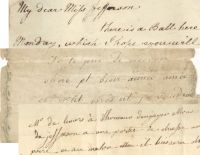Saving Monticello : The Newsletter
The latest about the book, author
events, and more
Newsletter Editor - Marc Leepson
Volume XII, Number 11 November
1, 2015
URIAH
LEVY’S GIFT: I recently came across an excellent on-line article on the history of
the statue of Thomas Jefferson that Uriah Levy commissioned in 1833 that today
is the only privately donated statue in Statuary Hall in the Rontuda of the
U.S. Capitol.
The article, by
Linda Tederick, Assistant Curator at The White House, has great images and uses
Saving Monticello as one of its main
sources.
As I noted in the book Levy was in Paris taking time off from his U.S. Navy duties. He paid a visit to the 75-year-old Marquis de Lafayette, who had been a close friend of Jefferson’s since they met in Richmond during the Revolutionary War. Lafayette, who died in 1834, loaned Levy a portrait of Jefferson by the American painter Thomas Sully, which David used as his model for Jefferson's face.
Levy stayed in Paris until David completed the statue early in 1834. It stands seven-and-a-half feet tall and depicts Jefferson holding a quill pen in his right hand. In his left is an etched, word-for-word copy of the Declaration of Independence, complete with signatures, including the large “John Hancock.” Behind him are two large books, topped with a laurel wreath. The statue was cast in bronze, and Levy shipped both the finished statue and the plaster mold used to cast it to the United States.
On February 6, 1834, he presented the painted plaster model to the City of New York. The statue was placed on the second floor of the Rotunda at City Hall. It was moved into the ornate City Council Chamber in the 1950s where today it is the only piece of sculpture in a room filled with oil portraits.
A month after he gave the model to New York City, Uriah Levy presented the bronze Jefferson to the nation. He had the words “Presented by Uriah Phillips Levy of the United States Navy to his fellow citizens, 1833,” etched on one side of the statue's bronze base. It was displayed inside the Capitol, in the Rotunda.
Sometime during the
James K. Polk administration (1845-1949) the statue was removed from the
Rotunda. It was shipped up Pennsylvania Avenue to the White House where, with
the permission of President Polk, it was placed on the grounds on the north
side facing Lafayette Park. The photo above was taken around in the 1860s. It remained there until 1874 when the statue was
cleaned up (it had suffered badly from exposure to the elements) and moved into
National Statuary Hall in the Capitol Rotunda, where it stands today.
To read the article,
go to www.whitehousehistory.org/uriah-levys-gift-to-the-nation
TEEN-AGED MARTHA: A new cache of
letters, including a group of previously private missives written by Martha
Jefferson Randolph, Thomas Jefferson’s oldest daughter who lived at Monticello
with her eleven children and inherited the place after her father died in 1826.
The letters were written when Martha she was in Paris while her father was U.S.
Minister to France (1784-89). They recently have been leant to the Thomas
Jefferson Foundation—the folks who own and operate Monticello—by a group of
Jefferson descendants.
You can read the letters—and many other documents—on the “Jefferson
Quotes and Family Letters” page on the Monticello web site at http://tjrs.monticello.org
Other documents in this
collection were compiled by Martha Randolph’s granddaughter Martha Jefferson Trist
Burke. They include descriptions and reminiscences about the cabin of John and Priscilla
Hemmings, who were enslaved at
Monticello. That material has helped Foundation’s Curatorial Department
interpret and present that space.
EVENTS: I have four events in September, as I continue
researching my next book, a biography of Barry Sadler, the U.S. Army Sergeant
who wrote and performed “The Ballad of the Green Berets.” The pub date is
November of 2016.
- Saturday, November 7 – A talk on the Marquis de Lafayette, and book signing for the Henry
Clay DAR Chapter in Annandale, Virginia
- Saturday, November 14 – A talk on Saving Monticello for the Providence DAR Chapter in Fairfax
City, Virginia.
- Thursday, November 19 – A talk and book signing at the Glen
Allen Branch Library, 10501 Staples Mill Rd., Glen Allen, Va. on Lafayette.
The event is free and open to the public. For info, call 804-290-9500.
- Friday, November 20 – A talk on the writing process for the
Vintage Ladies of Northern Virginia, in Brunswick, Maryland
- Saturday, November 21 – A talk on Lafayette and book signing
for the Colonel William Grayson SAR Chapter in Haymarket, Virginia.
If you’d like to arrange an event for any of my books, email
marc527psc@aol.com For more details on upcoming events, go to http://bit.ly/SMOnline,
the “Author Events” page on my website, www.marcleepson.com
Facebook,
Twitter: If you’re on Facebook, please send me a friend request. If
you’re on Twitter, I’d love to have you as a follower.
Gift
Ideas: If you would like a
personally autographed, brand-new paperback copy of Saving Monticello, e-mail me at Marc527psc@aol.com
Or go to http://marcleepson.com/signedbooks.html
to order copies through Second Chapter Books in Middleburg, Virginia. We also
have copies of Desperate Engagement, Flag, Lafayette






